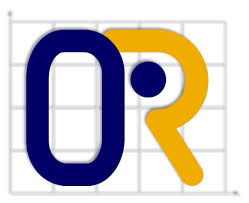What is Optimization?
Optimization problem: Maximizing or minimizing some function relative to some set, often representing a range of choices available in a certain situation. The function allows comparison of the different choices for determining which might be “best.”
Common applications: Minimal cost, maximal profit, best approximation, optimal design, optimal management or control, variational principles.
Definitions of Operational Research
- “OR is concerned with scientifically deciding how to best design and operate man-machine system usually requiring the allocation of scare resources.” – Operations Research Society, America
- “OR is essentially a collection of mathematical techniques and tools which in conjunction with system approach, are applied to solve practical decision problems of an economic or engineering nature’’. – Daellenbach and George
- “OR utilizes the planned approach (updated scientific method) and an interdisciplinary team in order to represent complex functional relationships as mathematical models for the purpose of providing a quantitative analysis’’. – Thieraub and Klekamp
- “OR is a scientific knowledge through interdisciplinary team effort for the purpose of determining the best utilization of limited resources.” – H.A. Taha
- “OR is a scientific approach to problem solving for executive management”. – H.M. Wagner
FEATURES OF Operational Research
The significant features of operations research include the followings:
(i) Decision-making: Every industrial organisation faces multifaceted problems to identify best possible solution to their problems. OR aims to help the executives to obtain optimal solution with the use of OR techniques. It also helps the decision maker to improve his creative and judicious capabilities, analyse and understand the problem situation leading to better control, better co-ordination, better systems and finally better decisions.
(ii) Scientific Approach: OR applies scientific methods, techniques and tools for the purpose of analysis and solution of the complex problems. In this approach there is no place for guess work and the person bias of the decision maker.
(iii) Inter-disciplinary Team Approach: Basically the industrial problems are of complex nature and therefore require a team effort to handle it. This team comprises of scientist/mathematician and technocrats. Who jointly use the OR tools to obtain a optimal solution of the problem. The tries to analyse the cause and effect relationship between various parameters of the problem and evaluates the outcome of various alternative strategies.
(iv) System Approach: The main aim of the system approach is to trace for each proposal all significant and indirect effects on all sub-system on a system and to evaluate each action in terms of effects for the system as a whole. The interrelationship and interaction of each sub-system can be handled with the help of mathematical/analytical models of OR to obtain acceptable solution.
(v) Use of Computers: The models of OR need lot of computation and therefore, the use of computers becomes necessary. With the use of computers it is possible to handle complex problems requiring large amount of calculations. The objective of the operations research models is to attempt and to locate best or optimal solution under the specified conditions. For the above purpose, it is necessary that a measure of effectiveness has to be defined which must be based on the goals of the organisation. These measures can be used to compare the alternative courses of action taken during the analysis.
PHASES OF Operational Research STUDY
OR is a logical and systematic approach to provide a rational basis for decision-making. The phases of OR must be logical and systematic.
The various steps required for the analysis of a problem under OR are as follows:
Step I. Observe the Problem Environment : The first step of OR study is the observation of the environment in which the problem exists. The activities that constitute this step are visits, conferences, observations, research etc. with the help of such activities, the OR analyst gets sufficient information and support to proceed and is better prepared to formulate the problem.
Step II. Analyse and Define the Problem: In this step not only the problem is defined but also uses, objectives and limitations of the study that are stressed in the light of the problem. The end results of this step are clear grasp of need for a solution and understanding of its nature.
Step III. Develop a Model: The next step is to develop model, which is representation of same real or abstract situation. OR models are basically mathematical models representing systems, process or environment in form of equations, relationships or formulae. The activities in this step is to defining interrelationships among variables, formulating equations, using known OR models or searching suitable alternate models. The proposed model may be field tested and modified in order to work under stated environmental constraints. A model may also be modified if the management is not satisfied with the answer that it gives.
Step IV. Selection of Data Input: It is a established fact that without authentic and appropriate data the results of the OR models cannot be trusted. Hence, taping right kind of data is a vital step in OR process. Important activities in this step are analyzing internal-external data and facts, collecting opinions and using computer data banks. The purpose of this step is to have sufficient input to operate and test the model.
Step V. Solution and Testing: In this step the solution of the problems is obtained with the help of model and data input. Such a solution is not implemented immediately and this solution is used to test the model and to find its limitations if any. If the solution is not reasonable or if the model is not behaving properly, updating and modification of the model is considered at this stage. The end result of this step is solution that is desirable and supports current organisational objectives.
Step VI. Implementation of the Solution: This is the last phase of the OR study. In OR the decision-making is scientific but implementation of decision involves many behavioral issues. Therefore, implementation authority has to resolve the behavioral issues, involving the workers and supervisors to avoid further conflicts. The gap between management and OR scientist may offer some resistance but must be eliminated before solution is accepted in totality. Both the parties should play positive role, since the implementation will help the organisation as a whole. A properly implemented solution obtained through OR techniques results in improved working conditions and wins management support.





8 Comments. Leave new
Good effort!
Very well explained!
Excellent work. Highly informative and impressive. 🙂
Very well written
You explained almost all aspects.. well done.. keep it up..
Well done! Nice job!
This was something new for me 😀
Frankly speaking you would pur some interesting stuff like examples in bettween to groom the reader’s attention 😀 . as when iwas reading it at first it was fine but like comming to the middle it was like please dont mind a bit of boaring 🙁
So make that if your writing a big one 😀 do take care about the readers mind also 😀
Good work : D by puting such a topic and feeding me with sufficient info 😀
really nice work